Development of a Space Grease Lubricant with Long-Term-Storage Properties
Abstract
:1. Introduction
- Primary particle size of thickeners < 1 μm and narrow size distribution to decrease Van der Waals attraction energy, which allows for effective stabilization by steric hinderance and reduces the impact of gravity.
- Particles with high roughness exhibit increased surface area and show better wettability.
- High oil viscosity reduces the speed of sedimentation.
- High wetting of the particle surface, achievable by use of surfactants or adjustment of surface energy of oil and thickener. The surface energy of the continuous phase should be similar but lower than the surface energy of the dispersed phase.
- Minimum density difference between oil and thickener compounds.
2. Materials and Methods
2.1. Raw Materials and Grease Manufacturing
2.2. Characterization of Formulation Properties
2.3. Validation of Lubricant Properties for Space Application and Verification of LTS Properties
3. Results and Discussion
3.1. Screening of Formulation Parameters
- A higher PTFE content increases viscosity, reduces oil separation, and enhances tribological SOT lifetime.
- The partial substitution of PTFE with an organo-modified bentonite slightly reduces viscosity and increases oil separation, but improves SOT lifetime.
- The use of an oil blend from Z-type and Y-type PFPEs significantly reduces oil separation and increases SOT lifetime.
- The combination of an antioxidant and a metal deactivator significantly increases SOT lifetime.
3.2. Formulation Validation
4. Conclusions
Supplementary Materials
Author Contributions
Funding
Data Availability Statement
Acknowledgments
Conflicts of Interest
References
- ESA. Space Engineering—Mechanisms; ECSS-E-ST-33-01C Rev.2; ESA-ESTEC R& SD: Noordwijk, The Netherlands, 2019. [Google Scholar]
- Bhat, B.N. Aerospace Materials and Applications, 1st ed.; Progress in Astronautics and Aeronautics; Aerospace Research Central: Lawrence, KS, USA, 2018; Volume 255, pp. 424–427. [Google Scholar]
- Hilton, M.R.; Fleischauer, P.D. Lubricants for High-Vacuum Applications; Aerospace Report No TR-0091(6945-03)-6; The Aerospace Corporation: El Segundo, CA, USA, 1993. [Google Scholar]
- Roberts, E.W. Space tribology: Its role in space in spacecraft mechanisms. J. Phys. D Appl. Phys. 2012, 45, 503001. [Google Scholar] [CrossRef]
- Roberts, E.W.; Eiden, W. Space Tribology Handbook, 5th ed.; ESR Technology Ltd.: Warrington, UK, 2013. [Google Scholar]
- Rudnik, L.R. Synthetics, Mineral Oils and Bio-Based Lubricants, 3rd ed.; CRC Press: Boca Raton, FL, USA; Taylor & Francis Group: Abingdon, UK, 2020. [Google Scholar]
- Wolfberger, A.; Hausberger, A.; Schlögl, S.; Holynska, M. Assessment of the chemical degradation of PFPE lubricants and greases for space applications: Implications for long-term on-ground storage. CEAS Space J. 2021, 13, 377–388. [Google Scholar] [CrossRef]
- Mori, S.; Morales, W. Reactions of Perfluoroalkylpolyethers (PFPE) with 440C Stainless Steel in Vacuum under Sliding Conditions at Room Temperature; NASA Technical Paper 2083; NASA: Washington, DC, USA, 1989.
- Buttery, M.; Gaillard, L.; Rajala, S.; Roberts, E.; Rohr, T.; Merstallinger, A. Fomblin Z25: A New Method for Its Degradation Assessment & Proposal for Safe Operation in Space. In Proceedings of the ESMATS, Noordwijk, The Netherlands, 25–27 September 2013. [Google Scholar]
- Fukuchi, T. Degradation of perfluoropolyether fluids with metal ions. ASME Trans. 1999, 121, 348–351. [Google Scholar] [CrossRef]
- Gleirscher, M.; Wolfberger, A.; Schlögl, S.; Holynska, M.; Hausberger, A. Accelerated thermo-catalytic degradation of perfluoropolyether lubricants for space applications. Lubricants 2023, 11, 81. [Google Scholar] [CrossRef]
- Prozhega, M.V.; Reschikov, E.O.; Smirnov, N.I.; Smirnov, N.N. Lubricating materials for mechanisms operating in space. J. Frict. Wear 2018, 39, 335–340. [Google Scholar] [CrossRef]
- Pouzar, J.; Kostal, D.; Sperka, P.; Krupka, I.; Hartl, M. Experimental study of space lubricant evaporation in a high vacuum environment. Vacuum 2024, 219, 112758. [Google Scholar] [CrossRef]
- Kent, A.; Roberts, E.; Stanley, S. Evaporation Lives of Space Oils; ESA-ESTL-TM-0162; ESR Technology Ltd.: Warrington, UK, 2013. [Google Scholar]
- Bertrand, P.A. Chemical degradation of a multiply alkylated cyclopentane (MAC) oil during wear: Implications for spacecraft attitude control system bearings. Tribol. Lett. 2013, 49, 357–370. [Google Scholar] [CrossRef]
- Kuerten, D.; Khader, I.; Kailer, A. Tribochemical degradation of vacuum-stable lubricants: A comparative study between multialkylated cyclopentane and perfluoropolyether in a vacuum ball-on-disc and full-bearing tests. Lubr. Sci. 2020, 32, 183–191. [Google Scholar] [CrossRef]
- Dube, M.J.; Bollea, D.; Jones, W.R.; Marchetti, M.; Jansen, M.J. A new synthetic hydrocarbon liquid lubricant for space applications. Tribol. Lett. 2003, 15, 3–8. [Google Scholar] [CrossRef]
- Braza, J.; Jansen, M.J.; Jones, W.R. Lubricated bearing lifetimes of a multiply alkylated cyclopentane and a linear perfluoropolyether fluid in oscillatory motion at elevated temperatures in ultrahigh vacuum. In Proceedings of the ESMATS, Liverpool, UK, 19–21 September 2007. [Google Scholar]
- Wolfberger, A.; Zehl, M.; Hausberger, A.; Tockner, M.; Schlögl, S.; Holynska, M.; Semprimoschnig, C. Effect of accelerated aging on the chemical signature and performance of a multiple-alkylated cyclopentane (MAC) lubricant for space applications. Tribol. Lett. 2021, 69, 3. [Google Scholar] [CrossRef]
- Space Materials Database. Available online: https://www.spacematdb.com (accessed on 13 December 2023).
- Buttery, M.; Lewis, S.; Kent, A.; Bingley, R.; Cropper, M. Long-term storage considerations for spacecraft lubricants. Lubricants 2020, 8, 32. [Google Scholar] [CrossRef]
- Senese, S.; Strube, B.; Lattner, K.; Fusco, G.; Deuschle, T.; Forster, U.; Thiel, M.; Svedevall, A.; Alvarez Toledo, A.; Sghedoni, M.; et al. Meteosat third generation (MTG) mechanisms: Impact on instrument performances. In Proceedings of the 18 European Space Mechanisms and Tribology Symposium, Munich, Germany, 18–20 September 2019. [Google Scholar]
- Munafo, P. Braycote Grease Retains Tribological Properties for 17 Years in Controlled Storage; NASA Engineering and Safety Center Technical Bulletin No 07-01; NASA: Washington, DC, USA, 2007.
- Henry, T.; Holynska, M. Investigation of long-term storage of space materials for future constellation missions: Study of Braycote 601 EF lubricant. IOP Conf. Ser. Mater. Sci. Eng. 2023, 1287, 012011. [Google Scholar] [CrossRef]
- Baart, P.; van der Vorst, B.; Lugt, P.M.; van Ostayen, R.A.J. Oil-bleeding model for lubricating grease based on viscous flow through a porous microstructure. Tribol. Trans. 2010, 53, 340–348. [Google Scholar] [CrossRef]
- Zhang, Q.; Mugele, F.; van den Ende, D.; Lugt, P.M. A model configuration for studying stationary grease bleed in rolling bearings. Tribol. Trans. 2021, 64, 1127–1137. [Google Scholar] [CrossRef]
- Salomonnson, L.; Stang, G.; Zhmud, B. Oil/thickener interactions and rheology of lubricating greases. Tribol. Trans. 2007, 50, 302–309. [Google Scholar] [CrossRef]
- Lagaly, G.; Schulz, O.; Zimehl, R. Dispersionen und Emulsionen—Eine Einführung in die Kolloidik Feinverteilter Stoffe Einschließlich der Tonminerale, 1st ed.; Steinkopff: Heidelberg, Germany, 1997. [Google Scholar]
- Mollet, H.; Grubenmann, A. Formulation Technology—Emulsions, Suspensions, Solid Forms, 1st ed.; Wiley: Weinheim, Germany, 2000. [Google Scholar]
- Ebnesajjad, S.; Morgan, R.A. Applications of Fluorinated Additives for Lubricants. In Fluoropolymer Additives, 2nd ed.; Plastics Design Library; Elsevier: Amsterdam, The Netherlands, 2012; pp. 69–106. [Google Scholar]
- Mas, R.; Magnin, A. Rheology of colloidal suspensions: Case of lubricating greases. J. Rheol. 1994, 38, 889–908. [Google Scholar] [CrossRef]
- Kent, A.; Lewis, S.; Blanc, A. Guidelines for Qualification of New Fluid Lubricants. In Proceedings of the ESMATS, Warsaw, Poland, 20–22 September 2023. [Google Scholar]
- Buttery, M. Spiral orbital tribometer assessment of space lubricants. In Proceedings of the ESMATS, Vienna, Austria, 23–25 September 2009. [Google Scholar]
- Pepper, S.V.; Kingsbury, E.P. Spiral orbital tribometry—Part 1: Description of the tribometer. Tribol. Trans. 2003, 46, 57–64. [Google Scholar] [CrossRef]
- Carfagno, S.P.; Gibson, R.J. A Review of Equipment Aging Theory and Technology; NP-1558; Franklin Research Center: Durham, NC, USA, 1980. [Google Scholar]
- Kasai, P.H. Perfluoropolyethers: Intramolecular Disproportionation. Macromolecules 1992, 25, 6791–6799. [Google Scholar] [CrossRef]
- Hellman, P.T.; Gschwender, L.; Snyder, C.E. A review of the effect of metals on the thermo-oxidative stability of perfluoropolyalkylether lubricants. J. Synth. Lubr. 2006, 23, 197–210. [Google Scholar] [CrossRef]
- Hayashida, K.; Yamamoto, K.; Nishimura, M. Wear and degradation characteristics of perfluoroalkylpolyethers (PFPEs) in high vacuum. Tribol. Trans. 1994, 37, 196–200. [Google Scholar] [CrossRef]
- Lu, J.; Stirniman, M.J.; Gui, J. Catalytic decomposition of perfluoropolyether lubricants. IEEE Trans. Magn. 2003, 39, 749–753. [Google Scholar]
- ESA. Space Product Assurance—Thermal Vacuum Outgassing Test for the Screening of Space Materials; ECSS-Q-ST-70-02C Rev.2; ESA-ESTEC R& SD: Noordwijk, The Netherlands, 2008. [Google Scholar]
- Lewis, S.; Buttery, M.; Poyntz-Wright, O.; Kent, A.; Vortselas, A. Accelerated testing of tribological components—Uncertainties and solutions. In Proceedings of the ESMATS, Munich, Germany, 18–20 September 2018. [Google Scholar]
- Mori, S.; Morales, W. Degradation and Crosslinking of Perfluoroalkyl Polyethers under X-ray Irradiation in Ultrahigh Vacuum; NASA Technical Paper 2910; NASA: Washington, DC, USA, 1989.
- Herrera-Fierro, P.; Jones, W.R. Interfacial Chemistry of a Perfluoropolyether Lubricant Studied by XPS and TDS; NASA Technical Memorandum 106014; NASA: Washington, DC, USA, 1992.
- Herrera-Fierro, P. XPS Analysis of 440C Steel Surfaces Lubricated with Perfluoropolyethers under Sliding Conditions in High Vacuum; NASA Technical Memorandum 106548; NASA: Washington, DC, USA, 1994.
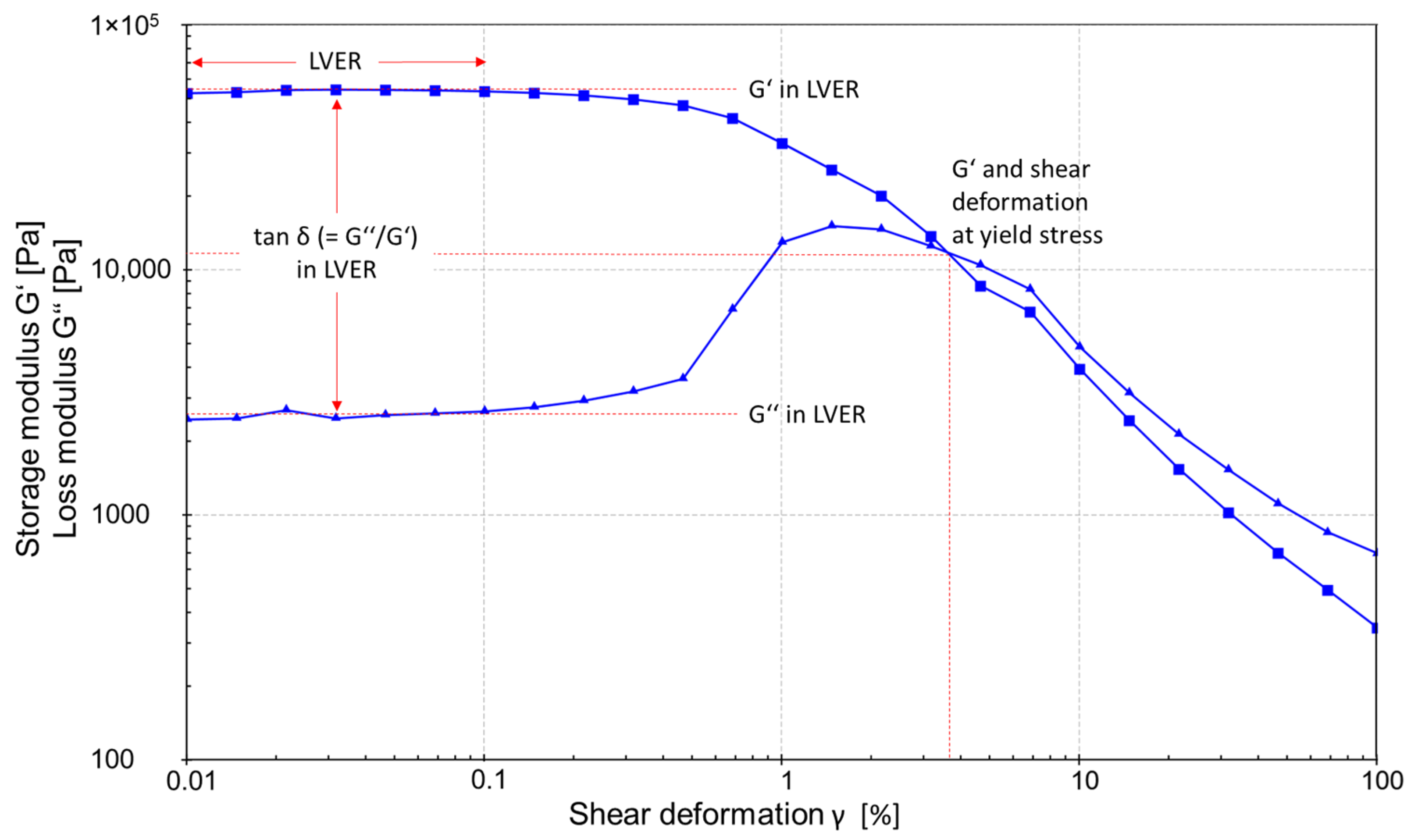

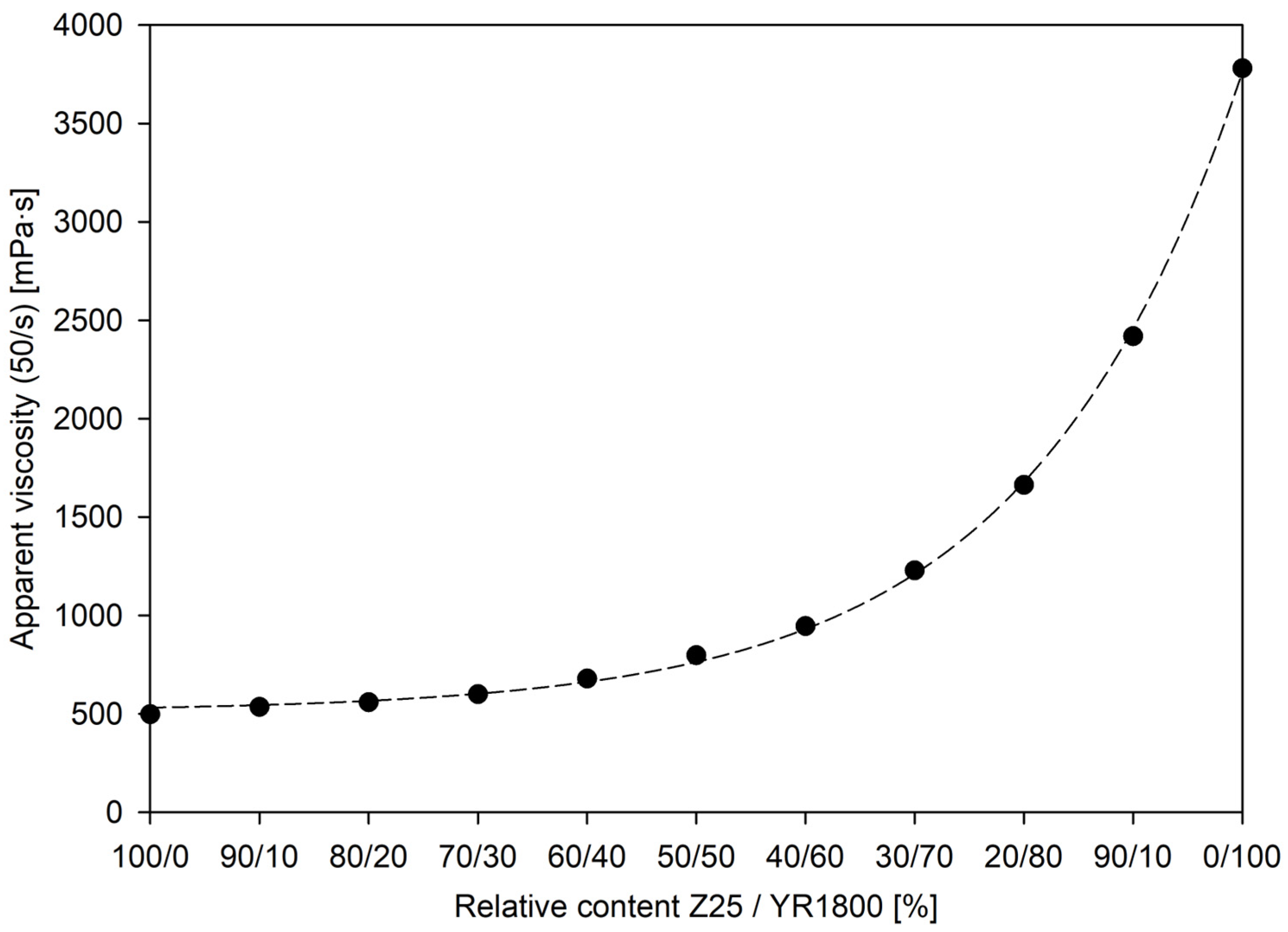

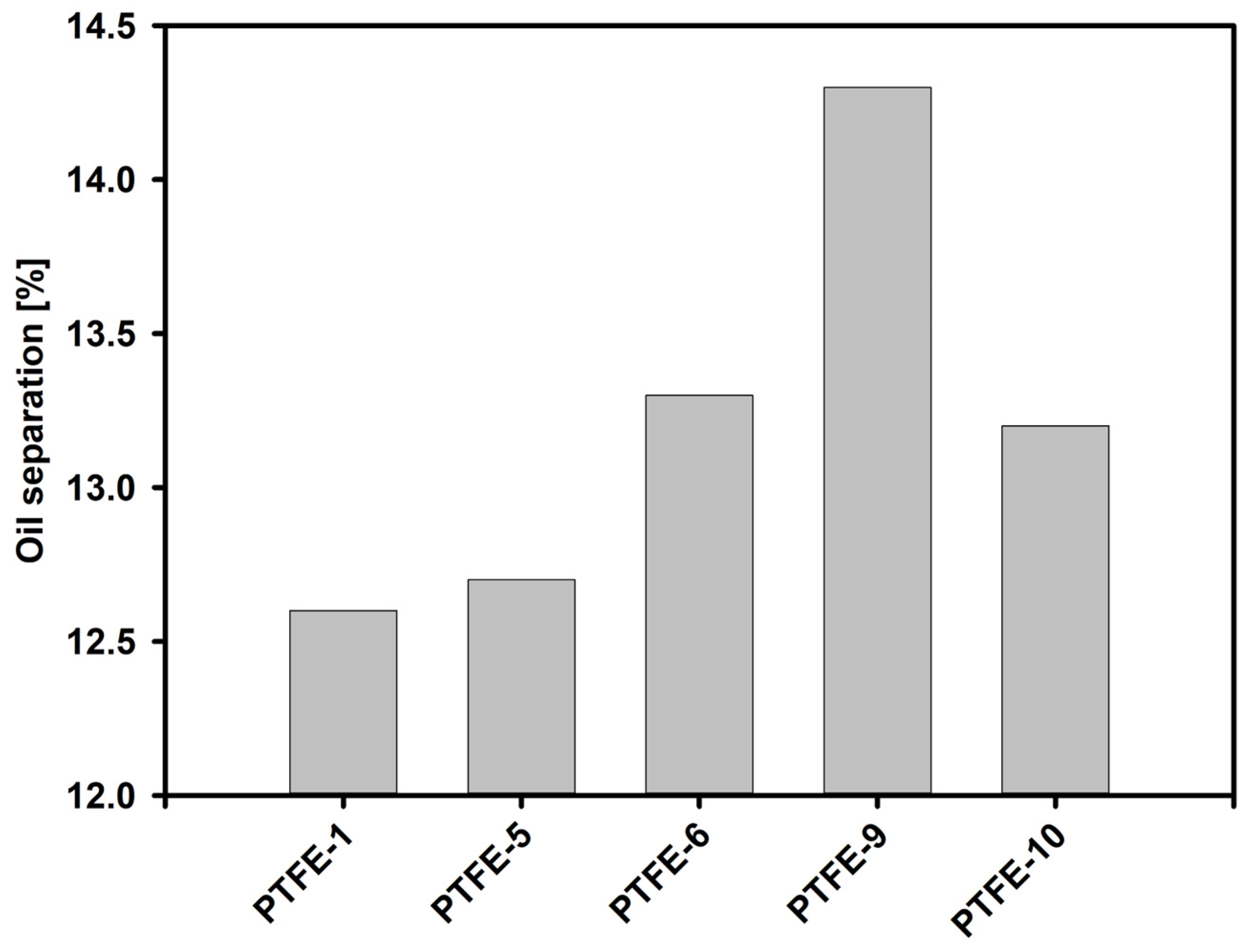

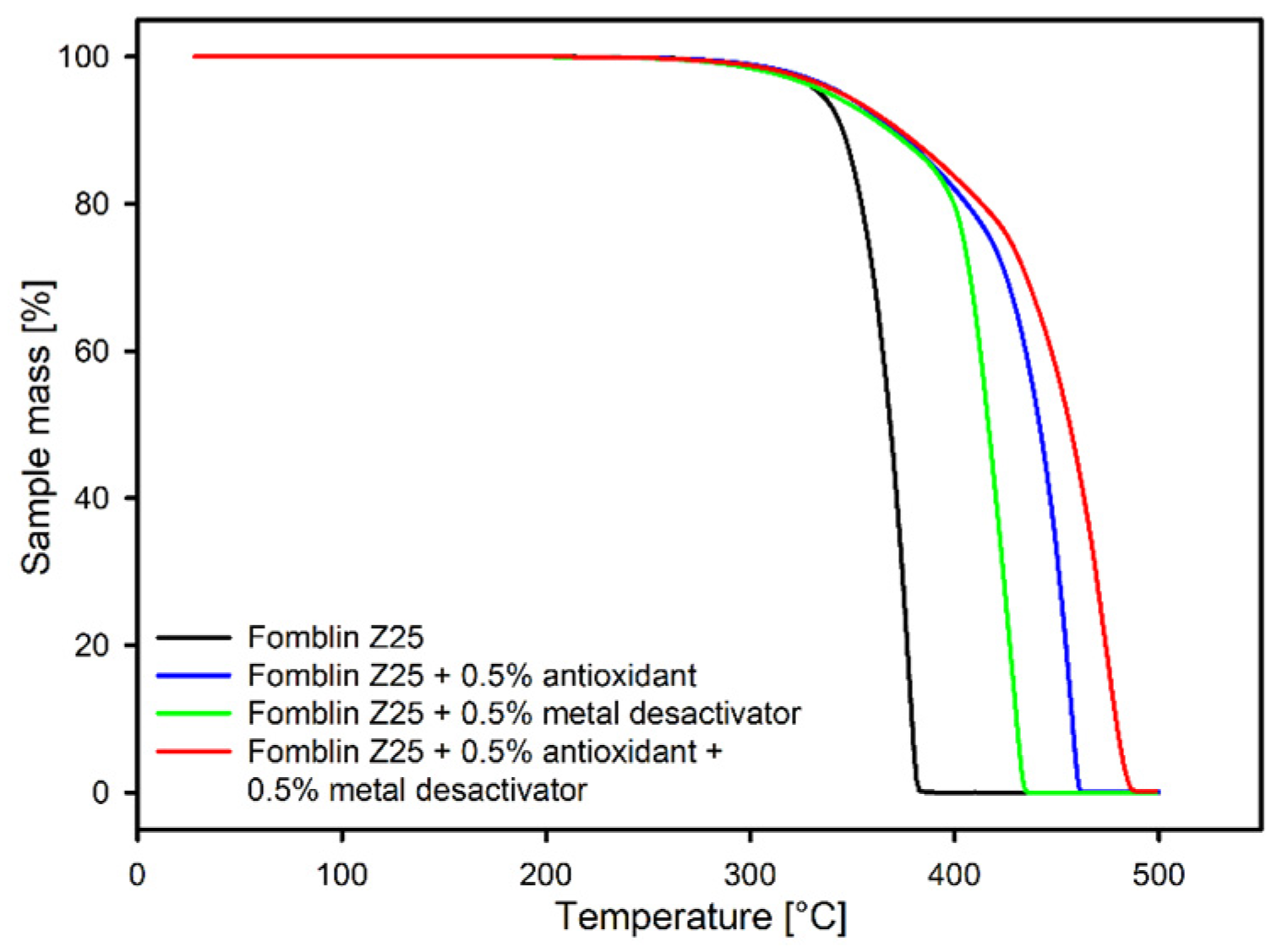

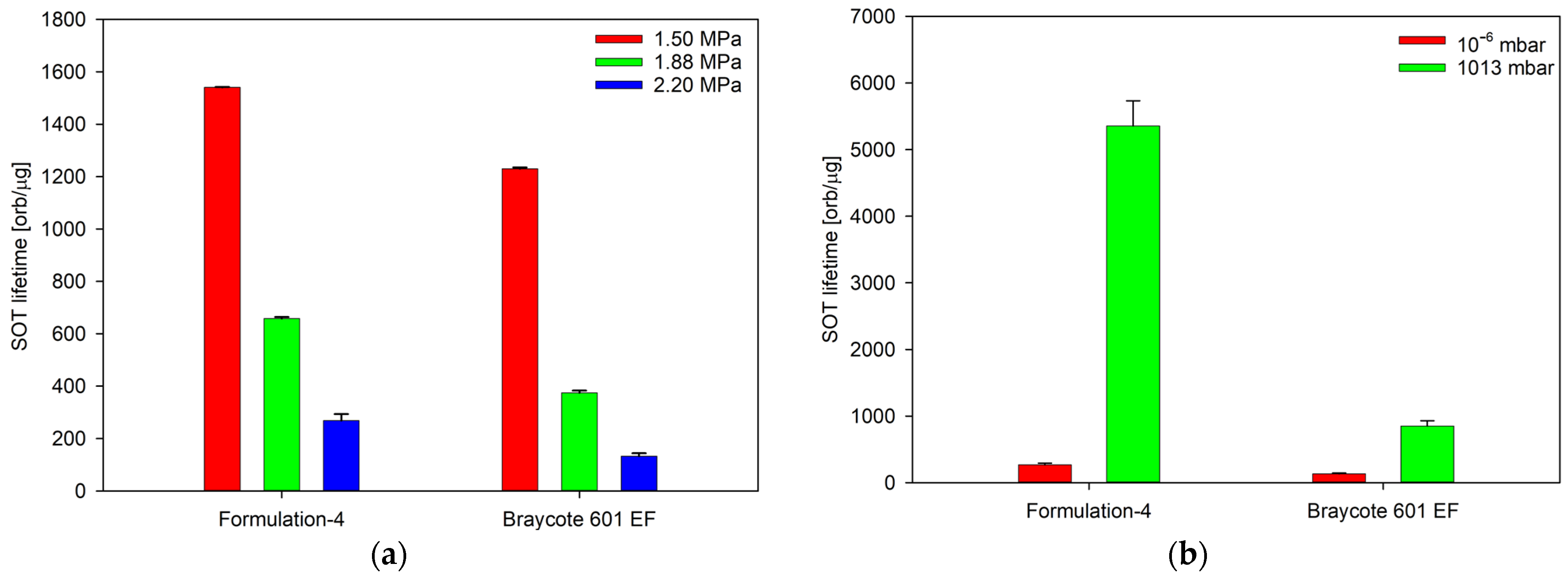
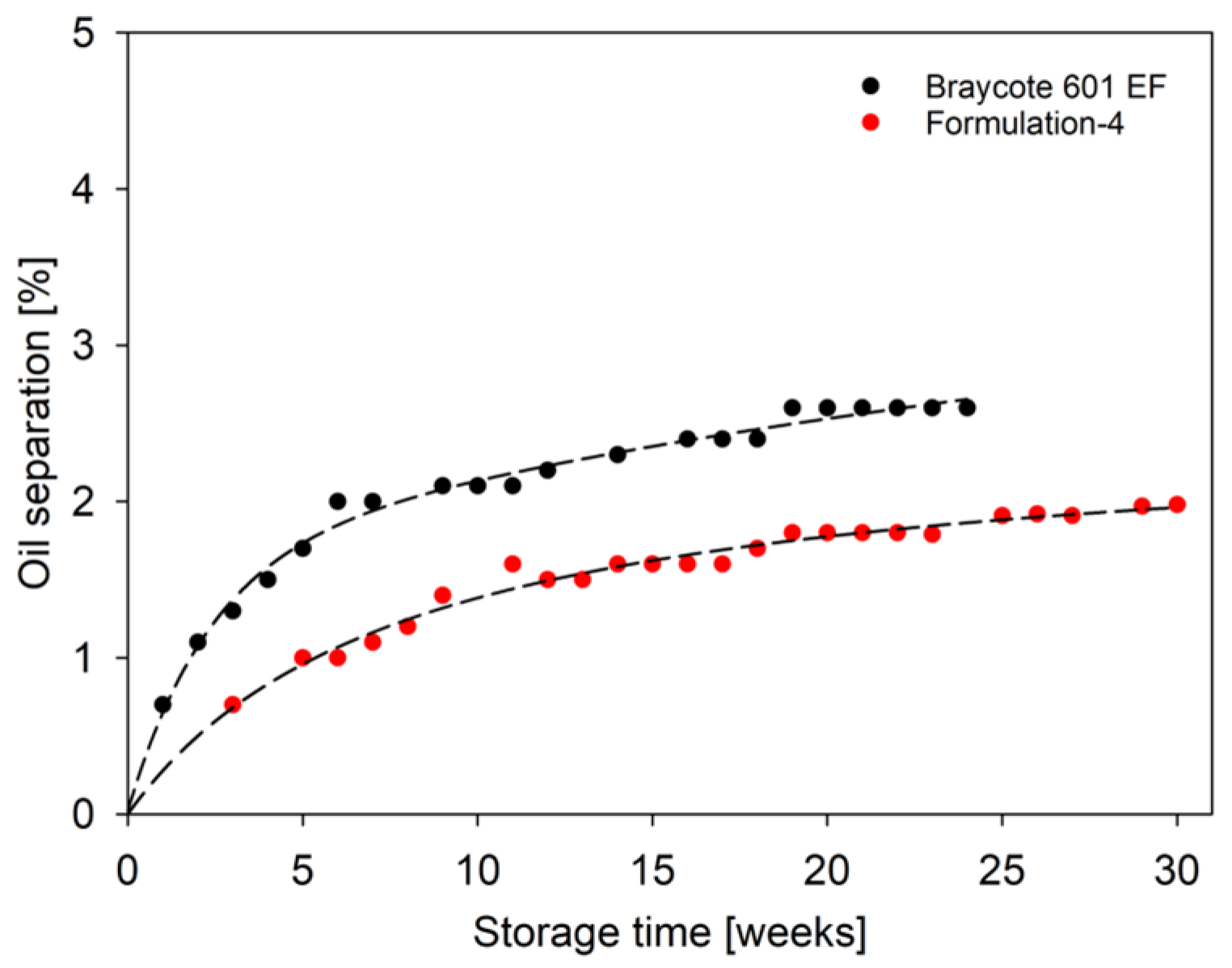
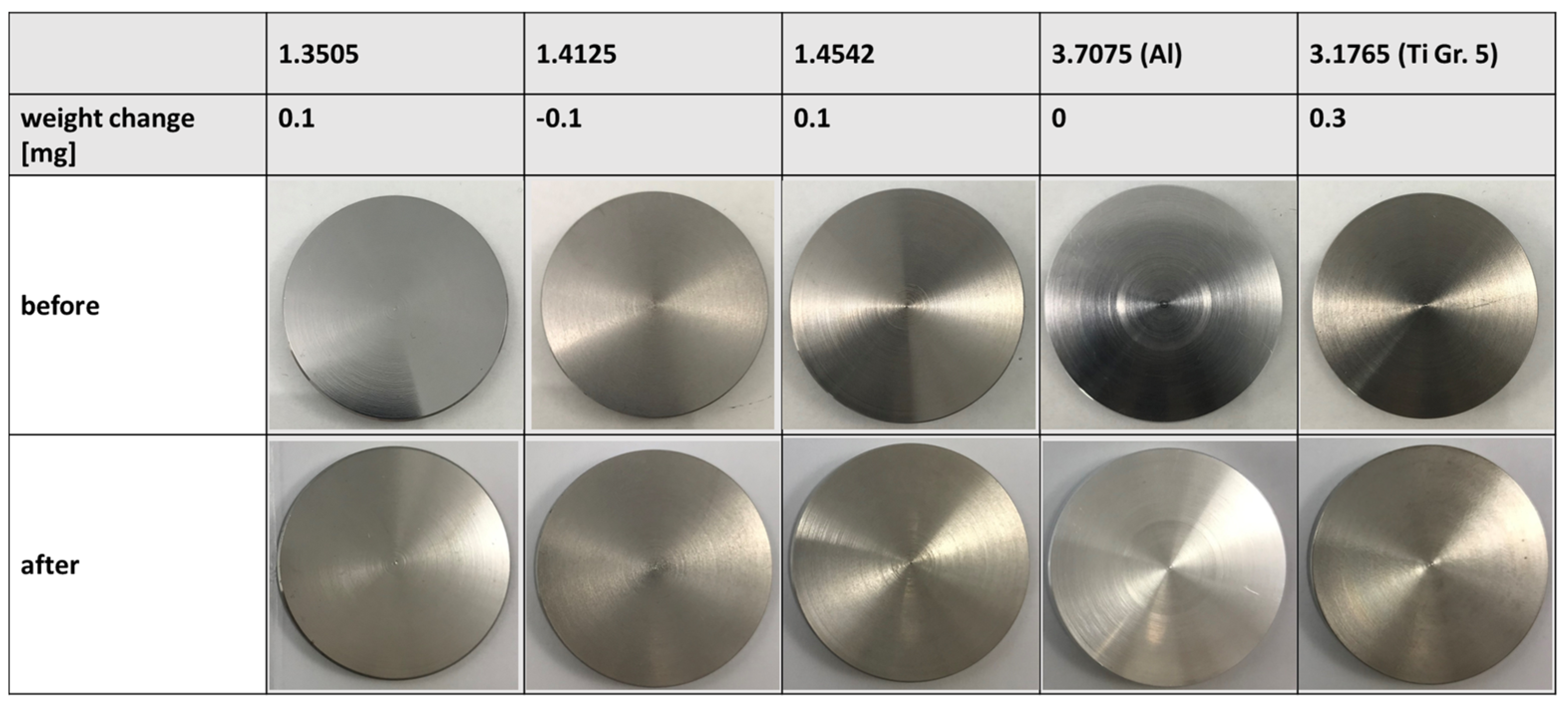
| Lubricant Oil | TML [%] | RML [%] | CVCM [%] |
|---|---|---|---|
| Fomblin Z25 | 0.06 | 0.01 | 0.01 |
| Nye Synthetic Oil 2001 | 0.61 | 0.58 | 0.07 |
| Test Category | Test Parameter | Test Standard | Desired Property Range |
|---|---|---|---|
| Base oil parameters | Pour point | ASTM D5950 | <−50 °C |
| Viscosity | DIN 51810-1 | 100–400 cSt (20 °C) 80–200 cSt (40 °C) 20–70 cSt (100 °C) | |
| Viscosity index | ASTM D2270 | >130 | |
| Viscosity | DIN 51810-1 | ca. 40 Pa∙s (20 °C, 10 s−1) ca. 5 Pa∙s (20 °C, 100 s−1) | |
| Grease parameters | Evaporation | ASTM D972 | <1 wt.-% |
| Outgassing | ECSS-Q-ST-70-02 | TML < 1%, RML < 1%, CVCM < 0.1% * | |
| Dropping point | ASTM D566 | 20 °C above maximum use temperature | |
| Oil separation | ASTM D6184 | <10% (204 °C, 30 h) |
| Property | Fomblin Z25 | Fomblin YR1800 |
|---|---|---|
| Density (20 °C) | 1.85 g/cm3 | 1.92 g/cm3 |
| Average molecular weight | 7300 g/mol | 17,100 g/mol |
| Kinematic viscosity (20 °C) | 223 cSt | 1850 cSt |
| Viscosity index | 350 | 148 |
| Pour point | −75 °C | −20 °C |
| Vapor loss (204 °C, 22 h) | 0.4 mass-% | 0.5 mass-% |
| Grease | Base Oil | PTFE Content | Additives | Average Lifetime (SOT) | Oil Separation (204 °C/30 h) | Viscosity (10/s) |
|---|---|---|---|---|---|---|
| Formulation-1 | Fomblin Z25 | 25% | - | 77 ± 6 orb/µg | 12.5% | 27.9 Pa∙s |
| Formulation-2 | Fomblin Z25 | 30% | - | 103 ± 27 orb/µg | 10.6% | 52.4 Pa∙s |
| Formulation-3 | Fomblin Z25 | 27% | Bentonite 3% Antioxidant 2% | 137 ± 8 orb/µg | 10.9% | 45.8 Pa∙s |
| Formulation-4 | Fomblin Z25/Fomblin YR1800 | 27% | Bentonite 3% Antioxidant 1% Metal deactivator 0.5% | 269 ± 21 orb/µg | 8.0% | 53.6 Pa∙s |
| Property | Formulation-4 | Braycote 601 EF |
|---|---|---|
| Density (20 °C) | 1.85 g/cm3 | 1.97 g/cm3 * |
| Kinematic viscosity (20 °C) | 223 cSt (20 °C) 167 cSt (40 °C) 36 cSt (100 °C) | 110–170 cSt (38 °C) * 40–50 cSt (99 °C) * |
| Viscosity index | 262 | 340 min. * |
| Pour point | −71 °C | −73 °C max. * |
| Vapor pressure (20 °C) | 2.1×10−13 mbar (Fomblin Z25) * 4.0×10−12 mbar (Fomblin YR1800) * | <5.3×10−13 mbar * |
| Property | Formulation-4 | Braycote 601 EF |
|---|---|---|
| TML | 0.16 | 0.19 |
| RML | 0.12 | 0.16 |
| CVCM | 0.03 | 0.05 |
| Dropping point | 200 °C | 182 °C min. * |
| Evaporation loss | 0.68% | 2% max. * |
| Peak Hertzian Contact Stress | Environment | Temperature | Number of Tests | Average Lifetime | Average Steady State Coefficient of Friction |
|---|---|---|---|---|---|
| 2.25 GPa | <1.3∙10−6 mbar | 22 ± 3 °C | 3 | 269 ± 25 orb/μg | 0.117 |
| 1.88 GPa | <1.3∙10−6 mbar | 22 ± 3 °C | 2 | 658 ± 6 orb/μg | 0.119 |
| 1.50 GPa | <1.3∙10−6 mbar | 22 ± 3 °C | 2 | 1541 ± 2 orb/μg | 0.119 |
| 2.25 GPa | <1.3∙10−6 mbar | 50 ± 3 °C | 2 | 207 ± 18 orb/μg | 0.108 |
| 2.25 GPa | <1.3∙10−6 mbar | 80 ± 3 °C | 2 | 157 ± 6 orb/μg | 0.092 |
| 2.25 GPa | 1013 mbar | 22 ± 3 °C | 2 | 5639 ± 377 orb/μg | 0.113 |
| Grease | Oil Separation (100 °C, 22 d) | Oil Separation (204 °C, 30 h) | Viscosity (10/s) | Viscosity (100/s) | Average Lifetime (SOT) | T 2% Mass Loss (TGA) |
|---|---|---|---|---|---|---|
| Formulation-4 before aging | 7.1% | 8.0% | 53.6 Pa∙s | 9.1 Pa∙s | 269 | 332 |
| Formulation-4 after aging | 8.1% | 9.5% | 64.2 Pa∙s | 10.4 Pa∙s | - | 317 |
| Formulation-3 before aging | 8.4% | 10.9% | 45.8 Pa∙s | 7.5 Pa∙s | 137 | 328 |
| Formulation-3 after aging | 9.5% | 11.7% | 46.6 Pa∙s | 7.6 Pa∙s | 198 | 325 |
| Braycote 601-EF before aging | 6.0% | 12.4% | 55.4 Pa∙s | 8.5 Pa∙s | 133 | 369 |
| Braycote 601-EF after aging | 7.6% | - | - | - | - | 375 |
Disclaimer/Publisher’s Note: The statements, opinions and data contained in all publications are solely those of the individual author(s) and contributor(s) and not of MDPI and/or the editor(s). MDPI and/or the editor(s) disclaim responsibility for any injury to people or property resulting from any ideas, methods, instructions or products referred to in the content. |
© 2024 by the authors. Licensee MDPI, Basel, Switzerland. This article is an open access article distributed under the terms and conditions of the Creative Commons Attribution (CC BY) license (https://creativecommons.org/licenses/by/4.0/).
Share and Cite
Schüler, F.; Holynska, M.; Henry, T.; Buttery, M.; Meier-Kirchner, K.; Göhringer, C. Development of a Space Grease Lubricant with Long-Term-Storage Properties. Lubricants 2024, 12, 72. https://doi.org/10.3390/lubricants12030072
Schüler F, Holynska M, Henry T, Buttery M, Meier-Kirchner K, Göhringer C. Development of a Space Grease Lubricant with Long-Term-Storage Properties. Lubricants. 2024; 12(3):72. https://doi.org/10.3390/lubricants12030072
Chicago/Turabian StyleSchüler, Fabian, Malgorzata Holynska, Théo Henry, Michael Buttery, Katrin Meier-Kirchner, and Christian Göhringer. 2024. "Development of a Space Grease Lubricant with Long-Term-Storage Properties" Lubricants 12, no. 3: 72. https://doi.org/10.3390/lubricants12030072
APA StyleSchüler, F., Holynska, M., Henry, T., Buttery, M., Meier-Kirchner, K., & Göhringer, C. (2024). Development of a Space Grease Lubricant with Long-Term-Storage Properties. Lubricants, 12(3), 72. https://doi.org/10.3390/lubricants12030072








